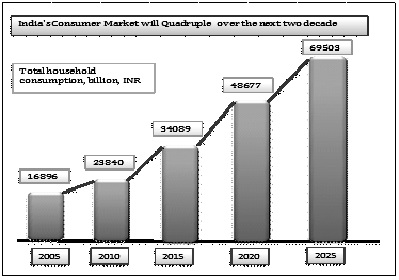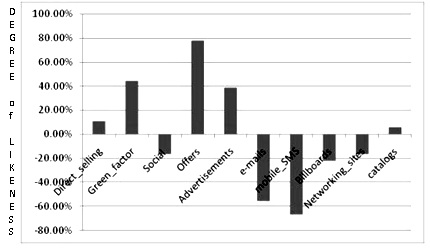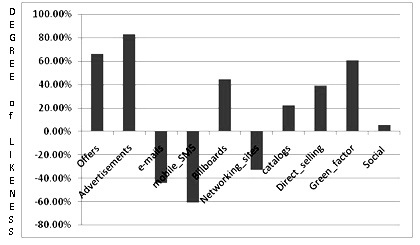Next Generation Marketing: An Indian Perspective
Faculty Contributor: Nagasimha Balakrishna Kanagal, Associate Professor
Student Contributors: Manish Kumar Urele and Suman Verma
The changing profile of the Indian customer has made it imperative for the marketer to change the way he communicates with the customer. The next generation Indian customers are educated, smart, equipped with technology and well informed through various media channels available now. On one hand, while rural markets have shown a tremendous growth Internet advertising has become the fastest-growing segment of total ad spending; rising at a rate of 20%1 in the first half of 2008. This article provides an integrated marketing view on the efficient use of next generation tactics such as blue ocean strategy, green marketing, permission marketing, buzz marketing, social marketing, ambush marketing etc. for the marketer to optimally utilize these favorable trends and reap the maximum benefits in terms of revenue growth and value creation to the customers.
India has been an attractive destination for marketers because of its growth potential as an emerging market. The average Gross Domestic Production (GDP) growth rate2 of India is 8.37% which indicates that future consumption will increase. The affluence level of the average Indian household has increased significantly. The per capita income has doubled from the 2002 - 2003 level of Rs. 18885 to Rs. 380843. Education level has reached to 79.9% in 2009 from a meager 34% in 19714. As shown in Exhibit 1, the research findings of McKinsey Global Institute indicate that the Indian consumer market is expected to quadruple by 2025, making it the fifth largest consumer market in world5.
 Exhibit 1: Growth in Indian consumer market
Exhibit 1: Growth in Indian consumer market
With the saturation of urban market, a shift towards the rural market is evident and high growth is expected in rural consumption. As the market is expanding, the customer is becoming rich, educated & tech-savvy with an increasing concern for society and environment. There are several implications for Indian marketers from this trend.
Next-Generation Marketing Strategies
In the view of the changing profile of Indian customers, marketers have been experimenting and utilizing different strategies to communicate and influence the new Indian customer. A number of techniques have been used to tap into wallets of the next generation customer some of which are:
Social Marketing: Social marketing is a process for influencing human behaviour on a large scale, using marketing principles for the purpose of societal benefit rather than for commercial profit.
Viral and Buzz marketing: Any strategy that encourages individuals to pass on marketing message to others, creating the potential for rapid multiplication to explode the message to thousands, to millions. Buzz marketing is a viral marketing technique that attempts to make each encounter with a consumer appears to be a unique, spontaneous personal exchange of information.
Mobile marketing: Mobile Marketing is a set of practices that enables organizations to communicate and engage with their audience in an interactive and relevant manner through any mobile device or network.
Blue ocean strategy: A blue ocean is created when a company achieves value innovation that creates value simultaneously for both the buyer and the company. The innovation (in product, service, or delivery) must create value for the market, while eliminating features or services that are less valued by future market.
Green Marketing: Green marketing is the marketing of products that are presumed to be environmentally safe so that the customers value the product.
Ambush marketing: Ambush marketing is as undeniably effective as it is damaging, attracting consumers at the expense of competitors, all the while undermining an event’s integrity and, most importantly, its ability to attract future sponsors.
Permission marketing: Permission marketing is an approach to selling goods and services in which a customer explicitly agrees in advance to receive marketing information.
However, the perception of these marketing strategies is not the same for the marketer and the customer. An analysis of the strategies adopted by the various marketers was done to understand this difference.
Marketer’s Perspective
With the changes in lifestyle there is increased pressure on the marketer to grab the attention of the customer. Increasing emphasis is laid on interactive social media tools such as radio channels, text messages and e-mails as well as social networking sites such as Orkut, Facebook, Twitter and company blogs. These media platforms enable the customers to discuss about the issues, likes-dislikes and recommendations.
Increasingly Indian consumers are also aware and concerned about the efforts companies make towards the conservation of environment and community development. The concept of Societal Marketing and Green marketing although decades old, is being increasingly used in recent times. In face, companies have started leveraging on these concepts to entice the “aware” customers. The ‘Jaago re’ campaign of Tata Tea, launched to create awareness about the voting right of Indian citizen, was very successful. ITC’s camapign of donating Re. 1 towards the education of poor students on every purchase of notebooks is an example of new tactics used by the “modern marketer”.
A study of bajaj and Hero Honda in the 2-wheeler segment presents the similar story. In the wake of the competition provided by Hero Honda, Bajaj has completely transformed its image of being a traditional family ‘scooter’ to a younger generation bike with marketing techniques like Bajaj pulsar ‘stuntmania’ which has been possible through the use of next generation marketing techniques such as gaming, virals, green marketing, buzz and rural marketing. Similarly Hero Honda has utilized these techniques consistently to remain a market leader in the category.
Thus our marketer is entirely focussed on integrating the current technologies with the marketing program in the form of emails, text messages, internet blogs, networking sites etc. However the attitude of customers towards these strategies is a bit different from the marketer’s viewpoint.
Customer Perspective
The customer’s perspective about these strategies has been collected and analysed through a survey about their preferences regarding various new generation marketing strategies. A distribution of consumer preferences for marketing strategies utilised in Fast Moving Consumer Goods (FMCG) and Durables segment was obtained as shown in Exhibit 2.
 Exhibit 2: Consumer preference to various advertizing techniques in FMCG
Exhibit 2: Consumer preference to various advertizing techniques in FMCG
For a typical Indian customer the new technological means are still way into the future and they are not able/willing to access them.
The survey findings revelaed that in FMCG category the customers value offers/discounts in the marketing efforts of the company as their highest priority. Consumers gave a clear distinction in terms of choosing three offerings of the marketers. A typical consumer rates discount offers, advertisements and the environmental benefit of a product over the other features. Mobile text messages and e-mails proved to score the lowest among all the offerings by marketers. For a typical Indian customer the new technological means are still way into the future and they are not able/willing to access them. As the executive of a leading car manufacturing company states “the customers are not very tech-savvy, and specially the buyers of luxury products are elderly persons who are very particular about the look and feel of the product.”
In the durable products section customers are more likely to prefer advertisements as shown from Exhibit 3. It is because the customers are mainly from the high end segment and less price sensitive. Mobile text messages still have the lowest preference in the mindset of the customers as far as marketing is concerned.
 Exhibit 3: Consumer preference to various advertizing techniques in Durables
Exhibit 3: Consumer preference to various advertizing techniques in Durables
From the qualitative analysis it is shown that the customers are slightly inclined towards the traditional methods such as advertising and communications using billboards.There is a need to educate people about the advancements in marketing techniques so that they may adapt to the more convenient and effective strategies which are coming in place in the 21st century.
FMCG and Durables’ Marketing
Based on the above analysis and by mapping the marketer’s perspective to the consumers’ preferences certain trends can be seen.
Visual and Interactive Ads on Mobile
Although Indian customer has become technologically advanced owing to changing demographics, as per the analysis he is still more affected by the traditional methods of marketing. Hence, communicating the same message to the customers on a new technological platform will enhance its acceptability. Customers need more visual and interactive platforms of marketing. Hence, marketers may send innovative multi-media messages (MMS) exhibiting the TV commercials to exploit the high mobile proliferation among the customers.
Focus on Green Marketing
As the customer has become more educated and affluent, the awareness regarding harmful effects of pollution and chemicals has increased. Therefore, the companies need to develop and emphasize their environmental friendly products in durables such as cars and hygienically safe products in FMCG such as eatables and soaps to tap potential customers.
Rejuvenating Customer Relationship Marketing (CRM)
In the changing trend of marketing innovations, customers should be involved in the marketing phase to capture a greater hold over the market. Some of these changes could be:
- Testimonials by customers: In products like ‘Pureit’ the testimonials from customers are utilized that exhibit that they are satisfied from the product. These strategies should be used and improved to involve customers in the marketing of products.
- Inviting suggestions for added features: For FMCG products such as ‘Kurkure’ inviting recipes from customers for preparing delicacies provides them incentives to spread Word-of-Mouth about these products.
Focus on Rural Masses
Given the fact that rural market is booming, marketers need to evolve and pursue rural marketing. It is desirable to provide the products in different SKUs so that their price comes in the range of the rural market’s affordability. Demonstrations about the product through workshops or camp based activities should be done for the less educated rural customer. Marketers can use innovative financial schemes to increase their reach to the rural customer particularly in the Durables product category.
Conclusion
The income of a typical Indian customer has risen and so has their preference for tech-savvy products. Yet, customers are still connected to the traditional ways of marketing. They have become more aware and have shown an inclination towards environment-friendly products. CRM has emerged as an important tool for marketers and it should be renovated by involving customers in the marketing phase through testimonials. Rural markets offer potential and need to be tapped by innovative strategies. Thus, though India has changed but traditional marketing strategies on new technology platforms can aid the marketer in reaching the new customer.
Keywords
Green Marketing, Mobile Marketing, CRM, FMCG, Marketing
Contributors
Nagasimha Balakrishna Kanagal is an Associate Professor in the Marketing area at IIM Bangalore. He holds a B.E Degree from Bangalore University and PGDM from IIM Ahmadabad. He has also done his MA, MS and PhD from University of Texas at Dallas. He can be reached at kanagal@iimb.ernet.in.
Manish Kumar Urele (PGP 2009-11) holds a Bachelor's Degree in Electrical Engineering from National Institute of Technology, Bhopal. He can be reached at manish.urele09@iimb.ernet.in.
Suman Verma (PGP 2009-11) holds a Bachelor's Degree in Electronics & Communication Engineering from National Institute of Technology, Jaipur. She can be reached at suman.verma09@iimb.ernet.in.
References
- Jessica E Vascellaro, Sep 4, 2008, “Gap Widens in Online Advertizing”, The Wall Street Journal, Asia Edition
- TradingEconomics.com Market watch, 2010, “India GDP growth Rate”, May 05, http://www.tradingeconomics.com/Economics/GDP-Growth.aspx?Symbol=INR, Last accessed on September 24, 2010
- Press Trust of India (PTI) News, 2009, “India’s per capita income doubles in 7 years to Rs38,08”, Feb 09, http://www.livemint.com/2009/02/09150714/India8217s-per-capita-incom.html, Last accessed on September 24, 2010
- Adlakha, Arjun, 1997, “International Brief, Population Trends: India”, April 1997, http://www.census.gov/ipc/prod/ib-9701.pdf, Last Accessed on September 24, 2010
- McKinsey Global Institute, 2005, “The ‘Bird of Gold’: The Rise of India’s Consumer Market”, http://www.mckinsey.com/mgi/publications/india_consumer_market/slideshow/main.asp, Last accessed on September 24, 2010
